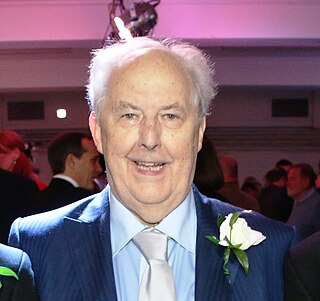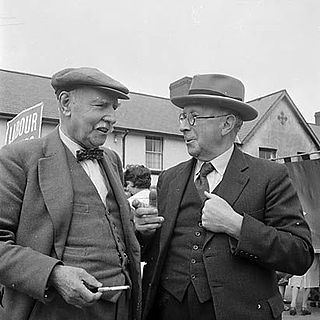Related Research Articles

William Williams, Pantycelyn, also known as William Williams, Williams Pantycelyn, and Pantycelyn, is generally seen as Wales's premier hymnist. He is also rated among the great literary figures of Wales, as a writer of poetry and prose. In religion he was among the leaders of the 18th-century Welsh Methodist revival, along with the evangelists Howell Harris and Daniel Rowland.

Aberystwyth University is a public research university in Aberystwyth, Wales. Aberystwyth was a founding member institution of the former federal University of Wales. The university has over 8,000 students studying across three academic faculties and 17 departments.

Tregaron is an ancient market town in Ceredigion, Wales. It is sited astride the River Brenig, a tributary of the River Teifi, and is 11 miles (18 km) north-east of Lampeter. According to the 2011 Census, the population of the ward of Tregaron was 1,213 and 67% of the population could speak Welsh; Tregaron is a community covering 33 square miles (85 km2); two-thirds of the population were born in Wales.

Llandovery is a market town and community in Carmarthenshire, Wales. It lies on the River Tywi and at the junction of the A40 and A483 roads, about 25 miles (40 km) north-east of Carmarthen, 27 miles (43 km) north of Swansea and 21 miles (34 km) west of Brecon.

Ann Griffiths was a Welsh poet and writer of Methodist Christian hymns in the Welsh language. Her poetry reflects her fervent Christian faith and thorough scriptural knowledge.

Sir John Rhŷs, was a Welsh scholar, fellow of the British Academy, Celticist and the first professor of Celtic at Oxford University.
Brinley Roderick Rees was a Welsh academic. He wrote extensively on classics, particularly the study of the Greek language. His early work was devoted to Greek papyri; a later publication was devoted to the life and letters of Pelagius.

David Benjamin Rees is a Welsh and English-language publisher, author, lecturer and minister in the Presbyterian Church of Wales since 1962. He is a leader of the Welsh community in Liverpool, and heads one of the city's five remaining Welsh chapels. His small publishing house, Modern Welsh Publications Ltd, was established in 1963 and from 1963 to 1968 it operated from Abercynon in the Cynon Valley of South Wales. Since 1968 it has operated from Allerton, Liverpool and is the only Welsh language publishing house still operating in the city of Liverpool.

Emrys George Bowen FRGS, FSA, also known as E. G. Bowen, was an internationally renowned geographer with a particular interest in the physical geography and social geography of his native Wales. A diminutive figure, Bowen was on the academic staff of the Department of Geography and Anthropology at the University College of Wales, Aberystwyth, from the 1920s and continued to write and lecture there until his death in 1983.

The United Theological College located in Aberystwyth, in the county of Ceredigion in mid Wales, is a Grade II listed building which was the ministerial training college of the Presbyterian Church of Wales from 1906 to 2003 and an associate college of the University of Wales.

Thomas Evan Nicholas, who used the bardic name Niclas y Glais, was a Welsh language poet, preacher, radical, and champion of the disadvantaged of society.
John Ellis Meredith (1904–1981) was a Welsh Presbyterian minister and writer. He was the first Welshman to become president of the National Union of Students.

Iorwerth Cyfeiliog Peate was a Welsh poet and scholar, best known as the founder, along with Cyril Fox, of St Fagans National Museum of History.
Brynley Francis Roberts, known as Bryn Roberts, was a Welsh scholar and critic, who wrote significantly on the Welsh language and Celtic history. He was Professor of Welsh Language and Literature at the University of Wales, Swansea 1978–1985 and Librarian of the National Library of Wales in 1985–1994, then made editor of the Dictionary of Welsh Biography in 1987 and of Y Traethodydd in 1999. He was on the council of the Honourable Society of Cymmrodorion and involved in the Morfa Chapel, Aberystwyth, part of the Presbyterian Church of Wales. In 2011, he was elected as a Fellow of the Learned Society of Wales.
The Dictionary of Welsh Biography (DWB) is a biographical dictionary of Welsh people who have made a significant contribution to Welsh life over seventeen centuries. It was first published in 1959, and is now maintained as a free online resource.

Llanfihangel-yng-Ngwynfa was a parish within the former historic county of Montgomeryshire. It now forms a major part of the community of Llanfihangel in Powys, which covers an area of 5,366 hectares (20.72 sq mi). Its Community Council extends to take in Dolanog and Llwydiarth, having approximately 413 registered voters. The parish originally consisted of the following townships: Cefncleisiog, Cydwnfa, Dolwar, Fachwen, Farchwell, Fynnonarthwr, Garthucha, Halfen, Llaethbwlch, Llwydiarth, Nanty-Candy, and Rhiewlas. Dolanog seceded from Llanfihangel in 1856.
Geraint Huw Jenkins, FBA, FLSW is a historian of Wales and a retired academic. He was Professor of Welsh History at the Aberystwyth University from 1990 to 1993, when he became Director of the University of Wales Centre for Advanced Welsh and Celtic Studies. In 2009, he retired from academia and was appointed Professor Emeritus of Welsh History at the University of Wales.
John Geraint Jenkins, known as J. Geraint Jenkins, was a Welsh maritime historian and historian of rural crafts.
Gruffudd ap Maredudd ap Dafydd was a Welsh bard working in Anglesey in the service of the Tudors of Penmynydd. One of the last of the older school of poets known as the Gogynfeirdd, he resisted the innovations in Welsh verse-form which took place in his lifetime. About 2400 lines of his work have survived in the Red Book of Hergest. His best-known poem is "Gwenhwyfar", an elegy to a young lady. He was described by the literary historian D. Myrddin Lloyd as "the finest of all the late Gogynfeirdd poets" and by Saunders Lewis as "one of the greats".

Aberystwyth Old Students' Association, founded in 1892, is Aberystwyth University's alumni association and is one of the oldest such associations in the United Kingdom. It currently has more than 9,500 Members and 83,000 Associate Members worldwide.
References
- 1 2 3 4 5 6 Davies, Hywel Meilyr. "Rees, Alwyn David". Oxford Dictionary of National Biography (online ed.). Oxford University Press. doi:10.1093/ref:odnb/75837.(Subscription or UK public library membership required.)
- ↑ Day, Graham (January 2010). "Rural Wales: The Sociological Account". Making Sense of Wales: A Sociological Perspective. pp. 141–. ISBN 9780708323106.
- 1 2 3 Bell, Colin; Newby, Howard (1971). "The European Studies". Community Studies: An Introduction to the Sociology of the Local Community. Routledge.
- ↑ Pahl, Ray (2011). "Book Review: Identities and Social Change since 1940: The Politics of Method". The Sociological Review. 59: 170. doi:10.1111/j.1467-954X.2010.01997_1.x. S2CID 149586465.
- ↑ Carter, Harold. "BOWEN, EMRYS GEORGE (1900-1983), geographer". Dictionary of Welsh Biography . National Library of Wales.
- ↑ Field, Clive D. (2015). Britain's Last Religious Revival?: Quantifying Belonging, Behaving, and Believing in the Long 1950s. Palgrave. p. 68. ISBN 9781137512536.
- ↑ Frankenberg, Ronald (1966). "British Community Studies: Problems of Synthesis". In Michael Banton (ed.). Social Anthropology of Complex Societies. Routledge. p. 128. ISBN 9781136539978.
- ↑ Williams, W. M. [William Morgan] (1964). The Sociology of an English Village: Gosforth. International Library of Society. Routledge & Paul.
- ↑ Ballin, Malcolm (2013). Welsh Periodicals in English: 1882-2012. University of Wales Press. pp. 94–5. ISBN 9780708326152.
- ↑ Mikhailova, Tatyana A. (2008). "Ireland's "Five Fifths" – A New Look". In Alexandra Bergholm; Katja Ritari (eds.). Approaches to Religion and Mythology in Celtic Studies. Cambridge Scholars Publishing. p. 199. ISBN 9781443808767.
- ↑ Morgan, Prys (1997). The University of Wales, 1939-1993. p. 128.
- ↑ Morgan, Prys (1997). The University of Wales, 1939-1993. p. 135.
- ↑ P. Jones; J. Sinclair; C. Cook; Jeffrey Weeks, eds. (25 April 1985). Sources in British Political History 1900-1951. Vol. 6. p. 235. ISBN 9781349178254.
- ↑ "Pantycelyn Lecture: 'A necessary person, Alwyn D. Rees (1911-1974): Battles long ago for Language and University". Aberystwyth University. 31 October 2019.